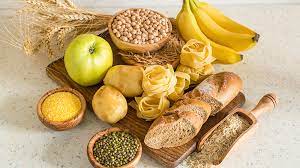Carbohydrates
Carbohydrates are the organic compounds i.e. essential biomolecules composed of carbon ,hydrogen and oxygen. The hydrogen and oxygen are in the ratio of 2:1 so they are also called "Hydrates of C...

Lipids are the the esters of fatty acids and glycerol made of C, H and O. However, the number of of oxygen is less as compared to carbohydrate.
They are insoluble in water but soluble in organic solvent like acetone, ether alcohol etc. They need large amount of oxygen for the the oxidation to release energy. The energy density yield of lipid is 37KJ/gm. The caloric value of 1gm of fat is 9.45kcal.
Fatty Acid

Fatty acids are the organic acids having hydrocarbon chain that in end carboxylic acid. They are carboxylic acid having long hydrophobic chain usually from 4 to 30.
General formula : -RCOOH
where R= Hydrocarbon chains and COOH= Carboxylic acid
Types of fatty acids
On the basis of bond formed between the carbon chains of fatty acids are of two types they are:
Unsaturated fatty acids
Saturated fatty acids
Types of lipids
On the basis of composition lipids categorized into tree types:
Simple Lipids

Fig: Triglyceride
They are esters of fatty acids and alcohol only. There are no additional compounds. On hydrolysis they yield fatty acid and alcohol.
They are broadly classified into Neutral or true fat, Oils and Wax
I) Neural or True Fat
These are esters of fatty acid and glycerol and are called glycerides each molecule of glycerol can react with maximum three molecules of fatty acids depending upon the number of fatty acid they are of three types
Monoglyceride: Consists of one molecule of glycerol and one molecule of fatty acid.
Diglyceride: Consists one molecule of glycerol and two molecules of fatty acid.
Triglyceride: Consists one molecule of glycerol and three molecules of fatty acid.
Triglyceride is the most common type of lipid in nature. It is formed by condensation of one molecule of glycerol with three molecules of fatty acid and removal of three molecules of water.
II) Oil
III) Waxes
Conjugated Lipids

Phospholipid: They are composed of lipid and phosphoric acid. They are the most important Lipids from biological point of view. They form plasma membrane and other endomembranes of a nerve tissue.
Glycolipid: They are composed of lipids and carbohydrates. They are found in membranes and are important constituents of white matter and nerve tissue.
Lipoprotein: They are composed of lipid and carbohydrates. Various types of lipoproteins are found in blood plasma.
Derived Lipids
They include hydrolyzed products of simple and complex Lipids. For example: Steroids, Terpenes, Carotenoids etc.
Steroids

Fig: Cholesterol
Steroids are the derived lipid composed of fused hydrocarbon rings and long hydrocarbon chains. Eg: Cholesterol, Diosgenin
Importance of Steroids :
Cholesterol is a precursor molecule for many sex hormones like progesterone, testosterone and adrenocorticotropic hormones like corticol.
Please Log In to ask your question.

is ester lipid?
Yes, ester may be lipid but note that only the ester of fatty acids are lipids. Esters (CH-O) are the bond formed between alcohol group and carboxylic acid (-COOH) by the removal of a molecule of water. And if such bond is formed between fatty acid that's lipid. Similarly ester bond can also be formed between Penrose sugar and phosphate group in DNA to form phosphodiester bond which is actually not a lipid so be careful that only the ester bond between fatty acids can be considered as lipids.